 |
George Forrest Memorial Medal Winners - 2007 |
| Home Recommend This Site To A Friend |
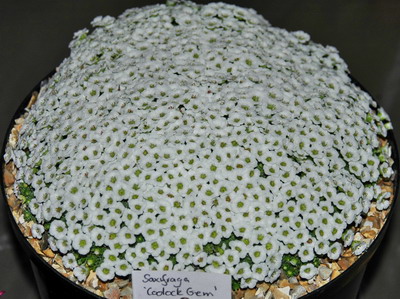
Blackpool 2007 Geoff Rawlinson from Holmfirth took the Forrest Medal with his wonderful Saxifraga 'Coolock Gem'. Geoff is a renowned expert in growing and exhibiting cushion plants, such as Dionysias and Androsaces as well as Saxifrages. He is a fixture at the Blackpool / Morecambe shows and has won many a Farrer medal for his fabulous exhibits. He has long been seen as the grower of the plants you have to beat'. I attended his lecture on Growing and Showing' at Alpines '91. His secret, so he said was to use lots of Bull S..t' in the compost. Plants like to be fed. This Saxifrage was a superb example of his expertise. Its wonderful white flowers glistened in a huge white dome. At the edges you could just catch an occasional glimpse of a bright green leaves. Skill in presentation is another of Geoff's talents, although this time there was scarcely any space to see any gravel at all! At present I don't have a picture of Geoff but here is Glassford's picture of his Saxifraga ?Coolock Gem'. Well done Geoff and congratulations for adding to your series of top awards. 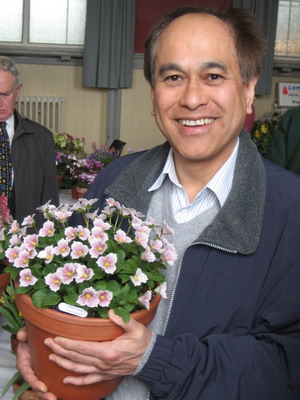
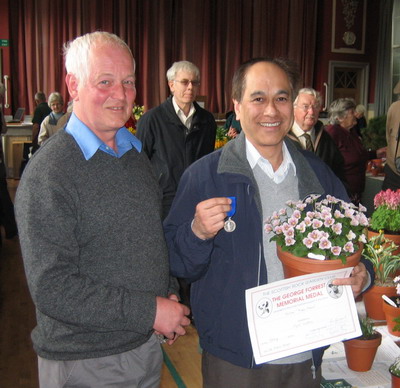
STIRLING SHOW IN DUNBLANE 2007 The maestro from Fife,Cyril Lafong scooped the top honours at the show. Trillium rivale 'Purple Heart' sparkled with reserved perfection on the bench. Its white upturned flowers are heavily speckled with purple dots, their density increasing towards the centre of the flowers. Hence the flower has a purple heart! Most forms of Trillium rivale seen on our benches are plain white. This exceptionally beautiful form is one to be sought out. Cushions, bulbs, alpines and woodlanders Cyril has gad success with all of them. Well done again Cyril! I am running out of superlatives to describe your plants! This was Cyril's 23rd [approximately] George Forrest Memorial Medal! SRGC President Ian Christie presented Cyril with his long overdue Silver Forrest Medal in the afternoon. Exhibitors who win 10 Forrest medals are given a Silver Forrest Medal. Cyril had to wait till new medals were struck as the original supply of 6 had been distributed. Cyril ran up his huge total while the SRGC sought out a new supplier. Two medals in one day! Congratulations and if we ever get a Gold Forrest I am sure Cyril will win the first one. 
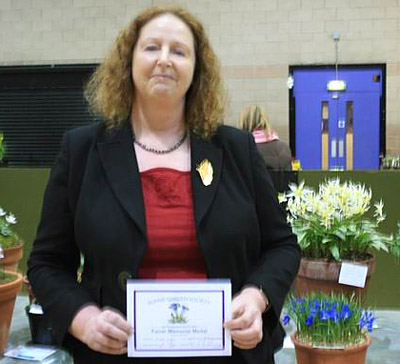
Hexham Show 2007 This year the joint SRGC/AGS Show at Hexham was held under AGS rules, so the plant judged Best in Show was awarded a Farrer Medal. The premier award went to this magnificent pot of Erythronium multiscapoideum. Della Kerr,who grew this fine plant from seed sown in 1987, is to be congratulated for showing this plant in pristine condition; a worthy winner with such flowers and perfect foliage too. 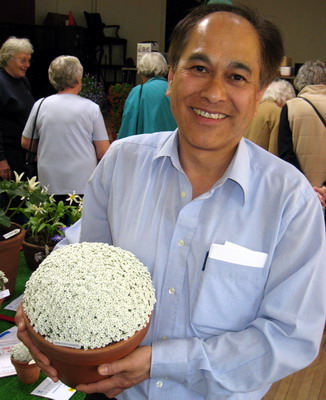
Edinburgh Show 2007 Cyril Lafong's 10 year old Androsace vandellii was the winner at Edinburgh. At one stage in the judging process the judges had to decide between two Androsace vandellii to see which was the better [ they both belonged to Cyril!]. The winning plant was in Cyril's 3 pan entry and he agreed that it was the better of the two. A complete hemisphere of white, the winner was truly a 'show stopper'. Cyril's presentation is always impeccable and if you want to see how show plants should be prepared and positioned then study Cyril's exhibits. However presentation is only a small part, the secret is in growing and looking after the plants. It must be very satisfying to see a seedling you have raised and nurtured for a decade win the ultimate accolade. Cyril deserves his success. In recent years the number of true high alpine exhibited has decreased slightly owing to the rising popularity of bulbous plants, so it is good to see a real alpine winner. I have no doubt that the plant has leaves but you just could not see any of them. Well done again Cyril. You are still setting the standards to which we all must rise. 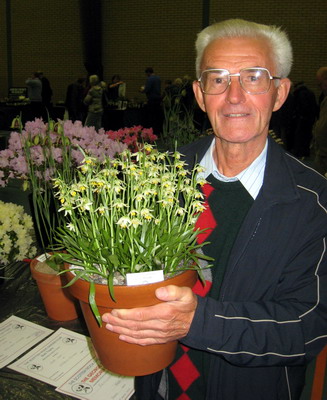
Perth Show 2007 Fred Hunt's Fritillaria liliaceae won the Forrest medal [ again! I am sure that in the past his F. liliaceae has had a Forrest at Perth] in a show packed with good plants. It is even more of a triumph at a show when the winning exhibitor is a local member. Fred lives in Invergowrie which is as close to Dundee as you can get but still be in Perthshire. For many years he has grown pans of Fritillarias to a standard of perfection which was unseen 20 years ago. This magnificent exhibit illustrates his standard. Fred tells me this is his 25th Forrest Medal, the highest number won by any living exhibitor. Fritillaria liliaceae is one of about 20 American Frit species, one of many popularised in British gardens by the late Wayne Roderick of San Francisco. Wayne attended several SRGC shows and would have been overjoyed to see this immaculate American frit win the top award. Fritillaria liliaceae is known colloquially in the USA as 'The Fragrant Lily' and as 'Prairie Bells'. It is native to Northern California, mainly in the San Francisco Bay area, near the coast. It grows in open grassland on clay soil, often derived from serpentine rock. Non-native plants rarely tolerate these serpentine soils, so that their plant communities are quite distinct and such areas form natural preserves of native plants and the animals which they support. Fritillaria liliaceae is under threat in California due to habitat loss and is described as having a 'limited distribution' and 'declining numbers'. Hopefully it is secure in cultivation and no more will be taken from the wild. I hope it grows as successfully in Californian nurseries as it does in Invergowrie. 
Glasgow Show 2007 Cyril Lafong took the top prize in consecutive years with the same plant, - his wonderful pan of Androsace studiosorum 'Doksa'. This is a very pretty species which forms a spreading mat instead of the domed shape we associate with many show Androsaces. It spreads by stolons, which can be seen in the picture, just like strawberries. The trick in getting a good show plant is to keep tucking the stolons with the little rosettes on the end, back into the pot and not let them spread out into the alpine house bed. The flowerheads are held upright on 5 cm scapes and are grouped into an ?umbel' each with 10 to 12 little white flowers. The individual leaf rosettes are soft pale green and the stolons, which when combined with the white flowers gives a very pleasing effect. Androsace experts will know that A. studiosorum is usually pink flowered. This fabulous white form was found in the Himalaya [Doksa Pass] by Margaret and Henry Taylor. They were as delighted as Cyril at the success of their introduction. For the second time. Well done Margaret and Henry for spotting the potential of the plant and well done Cyril for realising that potential. 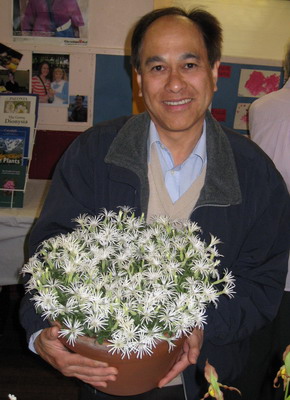
Aberdeen Show 2007 Cyril Lafong's Silene hookeri bolanderi won the Forrest Medal at this year's Aberdeen show. The large pan of glistening white spidery flowers was magnificent. Arachnohobes and Arachnophiles alike admired it. Cyril seems to be the only person in Scotland who exhibits it and certainly the only person who grows it so well. His skill in maintaining 'difficult' plants in top condition is marks him out as top grower. Silene hookeri is native to the Pacific Northwest of USA from Northern California up to and into British Columbia. It is usually pink hence its colloquial name of 'Oregon Indian Pink'. It is also known as 'Hooker's Catchfly, a name to be conjured with and mulled over in moments of quiet reflection. I remember being told that one of its sites was on the fairways of a golf course in BC. It would be a more refined 'weed' than daisies!. Pictures of it in the wild show that its petals vary in width, length and number. The flowers range from those whose petals almost touch to spidery flowers like bolanderi. Cyril won Forrests at Aberdeen in 2002 and 2003 with the same species, [same plant?]. I wrote in 2003, 'Well done again Cyril and thank you for your steadfast support of the SRGC shows. You have shown us what can be done. You have told us how to do it. How come you still do it better than we do?' That is still how I feel. 
Discussion Weekend Show Clydebank 2007 Best in show for the second week running was Jean Wyllies's magnificent pale pink flowered Cyclamen hederifolium. It is very seldom that a plant is in top condition at two successive shows. Jean scooped the Forrest medal at Ponteland last week and because the rules say that the same plant cannot win two Forrest medals in the same year, Jean could not get a second Forrest medal but she did have the Best Plant in Show. I first saw the plant on the Wednesday before the Ponteland show and it was truly splendid, just sitting in her greenhouse. I predicted that it would win at Ponteland. Similarly at Clydebank there was no plant as good. It must be galling to be denied a second medal but we all know who won. During his lecture on Alpine House plants Cyril Lafong recalled that one year his plant of Sebaea tommassii might have on three Forrest medals because it stayed in prime condition for three shows. Rarely has such a splendid example of a species well known s a garden plant been exhibited in such wonderful condition and with so many flowers. Well done Jean! ^ back to the top ^ |